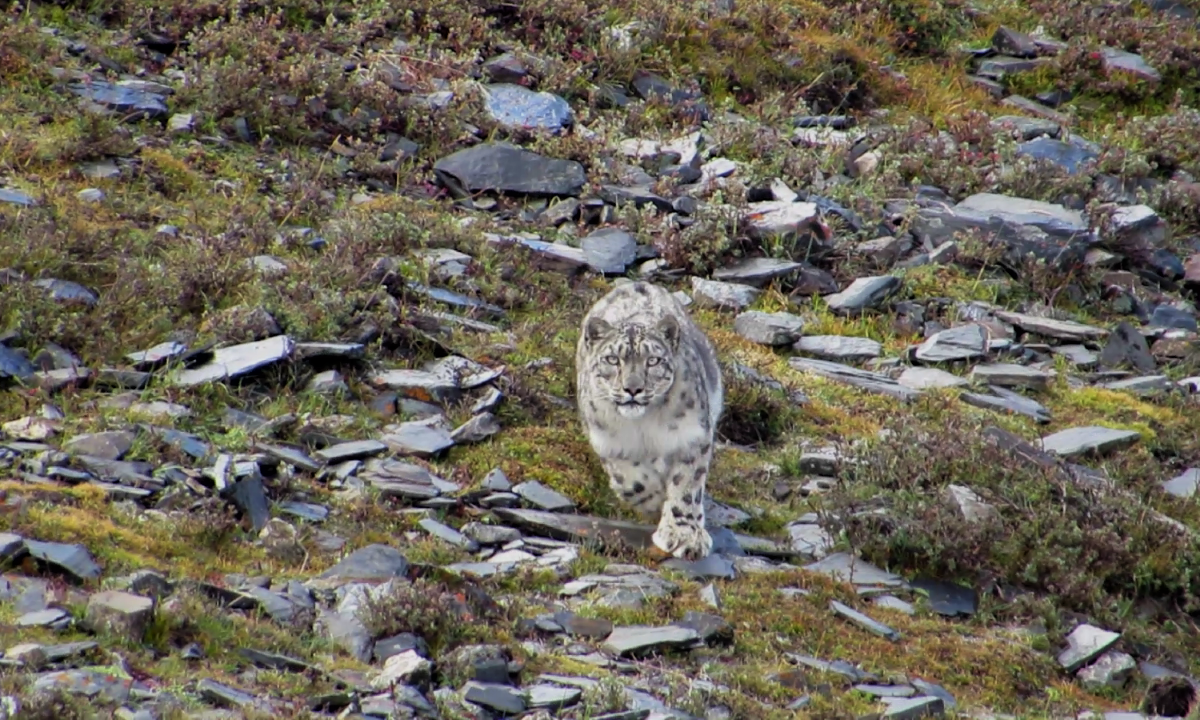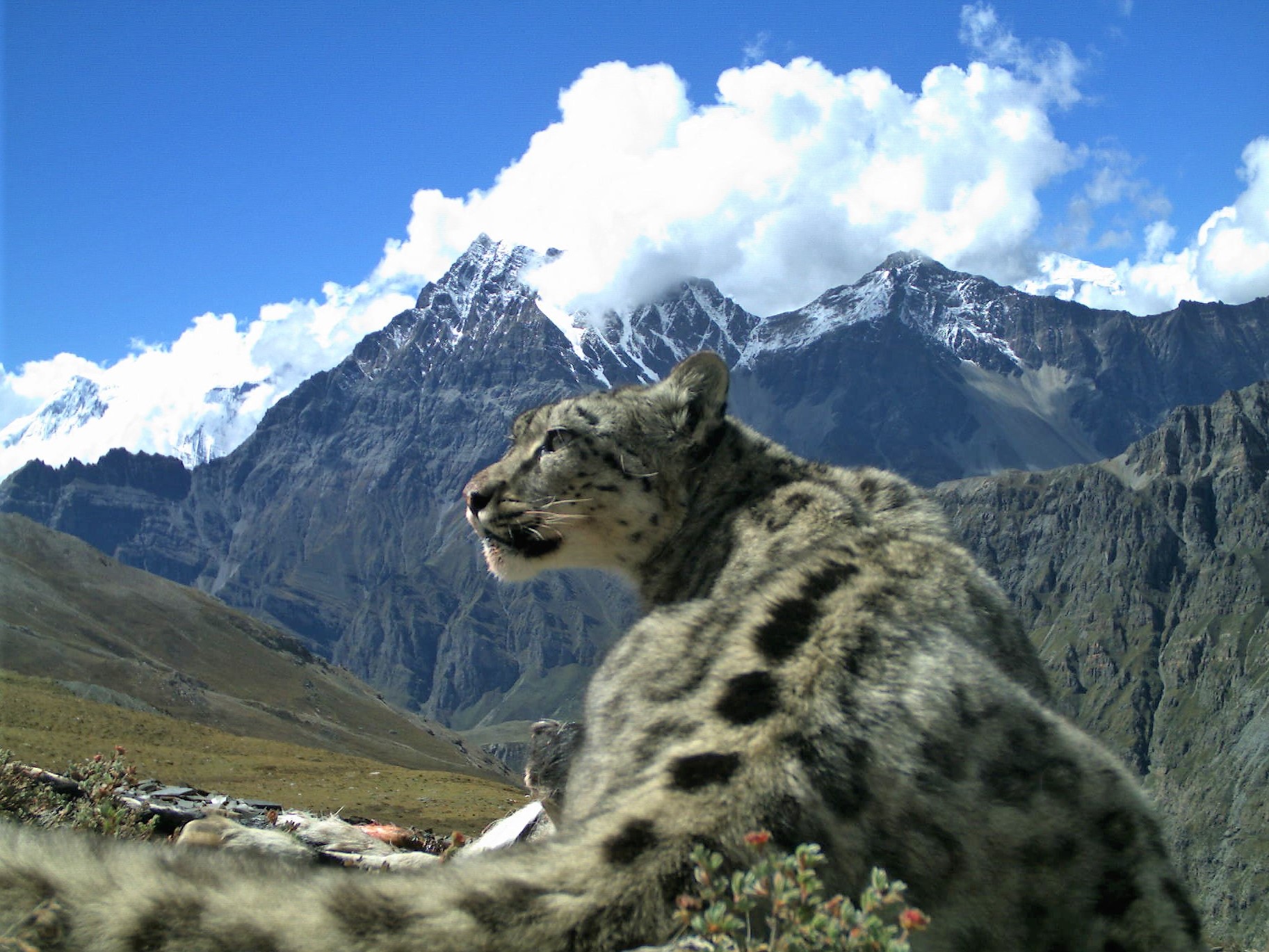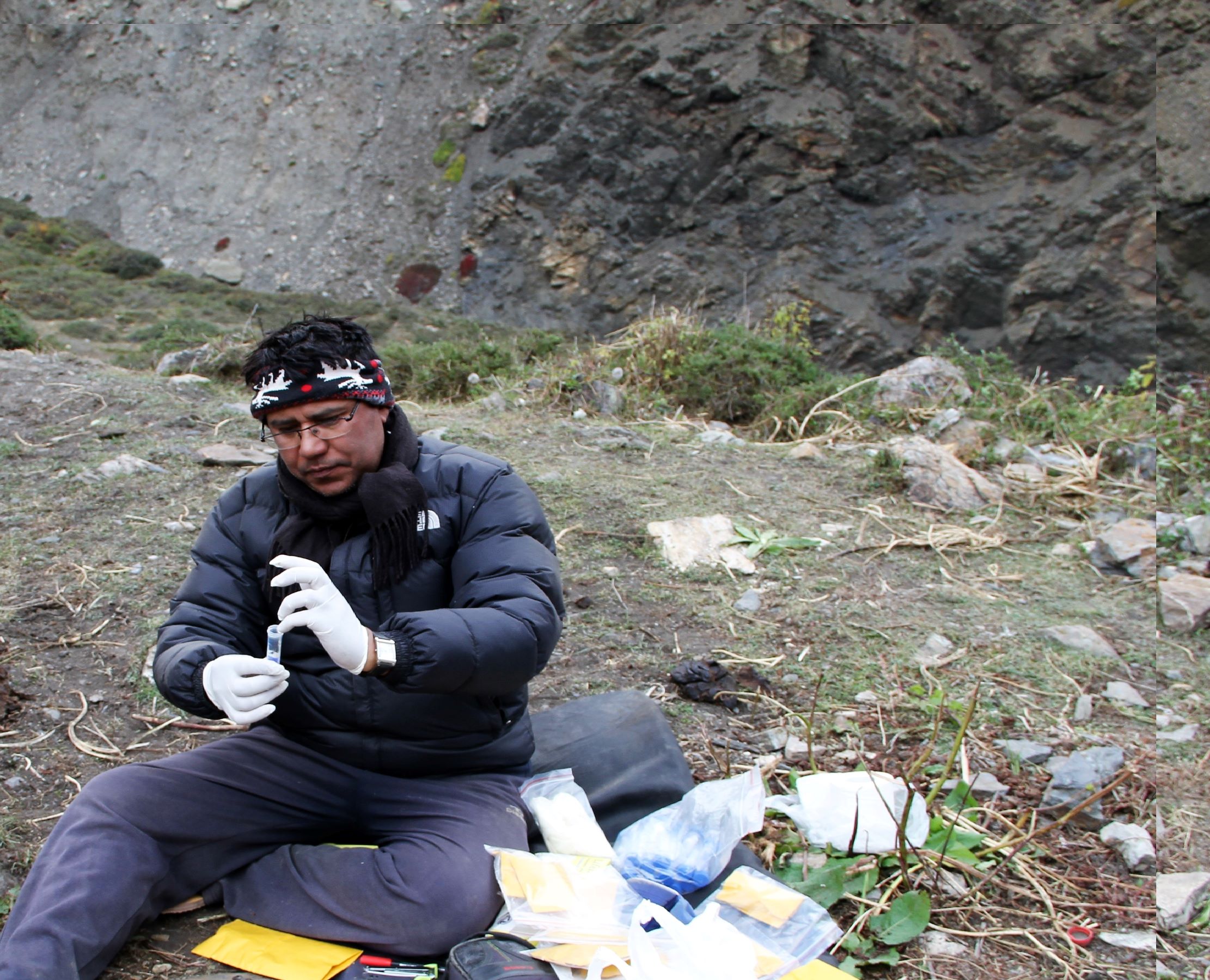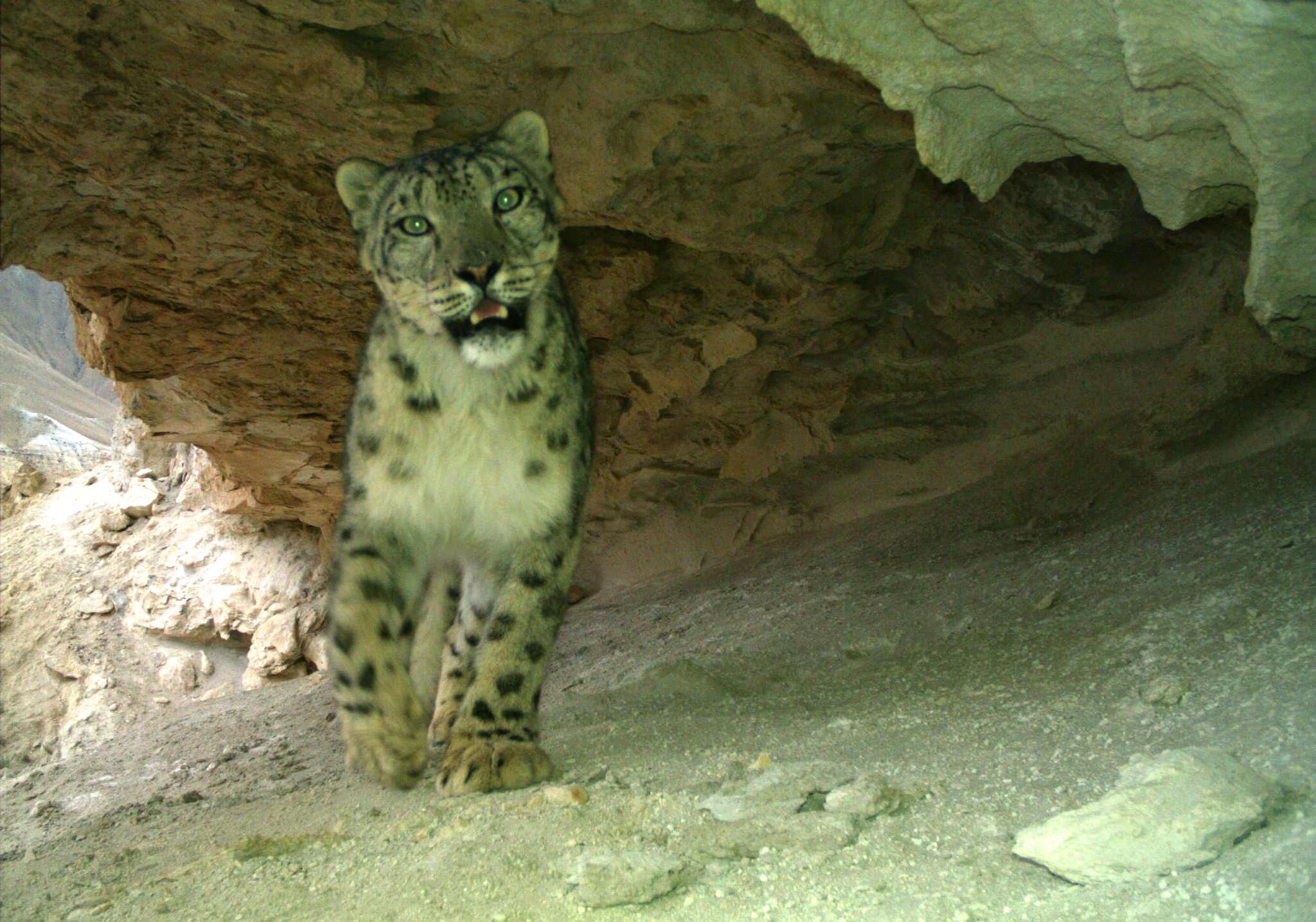
>>Researchers conducted a large-scale survey of potential snow leopard habitat in Nepal to re-estimate the species’ population density using the non-invasive technique of collecting environmental DNA from scat samples combined with standard genetic analyses.
>>This method enabled the researchers to sample a larger, more representative, area than many previous studies, often conducted in prime leopard habitats; they also found that they could obtain reliable DNA from scat samples.
>>Previous studies on which conservation policies have been based may have over-estimated the big cat’s population. The researchers say similar studies are needed to more accurately estimate the population of snow leopards in Nepal and 11 other range countries.
In September 2014, Nepali zoologist Madhu Chetri asked his professor Morten Odden a strange question during their fieldwork. “Are you tired?” he asked Odden as the duo from the Inland Norway University of Applied Sciences trekked the Annapurna region of Nepal, collecting scats of the elusive snow leopard for a DNA study. “Prof Odden asked me why I’d asked him such as question,” said Chetri, who recently completed his PhD. “I told him that there’s a rock in front of us, if you look behind it, you’ll find snow leopard scat.”
Snow leopards (Panthera unica) are shy cats ‘believed to be’ (a phrase used to describe almost anything related to the animal) living at extreme altitudes in the steep mountainous areas of 12 countries in central and South Asia. Until recently, less than 2 per cent of the animal’s geographic distribution has been sampled systematically, primarily in small survey areas.
“I worked in an area known as an important snow leopard habitat for over a decade, but I saw the animal with my own eyes only three times,” Chetri told Mongabay. He had a hunch that because only a tiny fraction of the species’ range, often areas considered to be prime leopard habitat, has been sampled so far, the population of these cats may have been overestimated.
The global snow leopard population is estimated to be between 4,678 and 8,745 individuals with an average density of 0.9–1.8 leopards per 100 square kilometres (2.3–4.7 per 100 square miles). In the case of Nepal, snow leopard densities estimated in different parts of the country using sign (scats and scrape marks) and radio telemetry data show higher densities than the global average.

A 1989 study in Langu Valley, Dolpa reported a density of 5–10 snow leopards per 100 square kilometers (13–26 per 100 square miles), following a 1997 study in Manang, Annapurna Conservation Area that reported 4.8–6.7 snow leopards per 100 square kilometers (12.4–17.3 per 100 square miles). “These studies conducted on small areas have formed the bedrock of all future estimates of snow leopards and policies to conserve them,” Chetri said.
Chetri wanted to buck this trend. In 2013, he was awarded a scholarship to carry out his PhD research on snow leopards at the Inland Norway University of Applied Sciences. His aim was to conduct a large-scale survey of a potential snow leopard habitat in Nepal and to re-estimate their densities using the DNA found in the animal’s scat. Due to constraints of time and resources, he chose the ‘central block’ (4,393 square kilometres, or 1,696 square miles) of the snow leopard habitat in Nepal so that other researchers could build on his work and do the same for the eastern and western blocks.
“I decided to use the DNA method mainly because of weather conditions in high altitude areas,” said Chetri, lead author of a recent paper in the Journal Global Ecology and Conservation. “Camera traps are hard to install at higher altitudes, as the batteries don’t function well in the cold,” he added. “Similarly, getting camera traps for a large-scale survey is costly.”

Leopard scats can provide robust environmental DNA
High-altitude areas tend to be dry, and this means that snow leopard scats remain preserved for a longer period of time. Also, having worked in the area for over a decade, Chetri knew where to go look for snow leopard scats.
The study area he and his colleagues chose was the Annapurna-Manaslu landscape, the northern part of which adjoins the vast Tibetan Plateau. Most of the area falls within these two conservation areas. The team defined the study area borders by delineating a minimum convex polygon around all scat sampling transects except in the northern section, where they used the Nepal-China boundary.
However, as the habitat of snow leopards lies above the tree line at elevations ranging from 3,000 to 6000 meters (9,843 to 19,685 feet), the researchers removed from the initial polygon areas considered too far above or below this elevation range, resulting in a survey area of 4,393 square kilometers, or 1,696 square miles.
The team collected 573 scats from 490 kilometres, or 305 miles, of transects within twenty-six 5 × 5-kilometre (3.1 x 3.1-mile) sized sampling grid cells of the survey area with 5–10 kilometres (3–6 miles) between grid cells. This, according to Chetri, covered about 15 per cent of the total study area.
“However, due to financial constraints, we used only 347 scat samples for our analysis,” he said. “We also collected scats on trails connecting the cells and along some trails that were beyond grid cell borders. We avoided placing grids on areas that were inaccessible due to high elevation or ruggedness.” They also avoided areas falling in and around large settlements and those with cultural restrictions.
Big cats such as leopards and tigers use their scats to mark their territory, and the team did not want to alter the natural environment for their study. So they only took half of the scat as sample and left the other half where they found it.

A population overestimation?
In September 2017, the International Union for Conservation of Nature (IUCN)‘down-listed’ the snow leopard’s extinction risk categorization.“Thanks to newly available data, the Snow Leopard has moved from the Endangered to Vulnerable category,” the IUCN reported before warning that “its population continues to decline and it still faces a high risk of extinction through habitat loss and degradation, declines in prey, competition with livestock, persecution, and poaching for illegal wildlife trade.” The change was prompted by new estimates that more than 8,000 wild snow leopards exist across Asia, with as many as 2,000 possible in China.
“The talk of this ‘down-listing’ had been going on for several years, and it was seen as inevitable,” said Chetri, who was further motivated by the development to finish his PhD research and determine whether surveying a large area would produce a more accurate population estimate than those based on surveys of known smaller areas of “prime habitat”.
Processing the DNA in the 347 scat samples using six microsatellite markers specifically designed for snow leopard confirmed that 182 samples were from snow leopards. Eighty-one of these gave sufficiently reliable high-quality results to show they belonged to 34 distinct individuals.
Chetri and his colleagues used maximum likelihood-based spatial capture-recapture analysis to develop models from the DNA analysis results to test the effects of various covariates on density and detection of scats on transects. They found that snow leopard density increased with elevation until a certain point, then began to decline. Detection of scat varied primarily with topography, and it was highest in dry river beds and ridge trails.
The analysis showed that the average density estimate of snow leopards for the central block within Nepal was around 0.95 animals per 100 square kilometres (2.46 per 100 square miles), with predicted densities varying between 0.1 and 1.9 animals in different parts—this was much lower than the 5-10 individuals per 100 square kilometres (13 to 26 per 100 square miles) density suggested by previous studies.

“Data from previous studies was extrapolated to say that Nepal was home to around 300-400 individuals,” Chetri said. “But if my data from the central zone is to be extrapolated in a similar way, it would suggest that only 48 individuals roam the centre block, and only 140 animals live in the 12,815 square kilometres (4,948 square miles) of potential snow leopard habitat in Nepal.”
“But we should not extrapolate in such a manner, as snow leopard densities are not the same even within the centre block, let alone the whole distribution range in Nepal. That is why need similar studies for the two remaining blocks,” he added.
He and his co-authors write that the results highlight the need for similar large-scale studies of the species in its 12 range countries. As range country governments prepare for PAWS (Population Assessment of the World’s Snow Leopards), which aims to produce a robust estimate of the threatened cat’s population status within the next four years, Chetri hopes that his findings will provide input for those involved in the count.
Zoologist Hem Sagar Baral, who was part of the technical team that prepared the Nepal Snow Leopard Action Plan (2017-21) said Chetri’s study shines new light on the ecologically important species. “The study’s inputs will definitely help policymakers incorporate the new findings when they sit for a mid-term review of the action plan soon,” Baral added.

After Chetri completed his PhD defence, it was Prof Oden’s turn to ask Chetri a strange question. “How did you know that day that there were two snow leopard scats lying next to the rock?” Chetri recollected quoting the professor.
“I told him, ‘I worked in the field for a decade and this was the most crucial factor in the research,’” he said. “On the surface, this study looks like a year-long effort, but this was a result of a decade-long work I did on snow leopards.”
This article was first posted on mongabay. Read the original article.






















